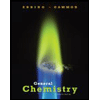
Chemistry the Central Science 13th Edition Custom for Lamar University
13th Edition
ISBN: 9781269962667
Author: Theodore L. Brown, H. Eugene LeMay Jr., Bruce E. Bursten, Batherine J. Murphy, Patrick M. Woodward, Matthew W. Stoltzfus
Publisher: Pearson Learning Center
expand_more
expand_more
format_list_bulleted
Textbook Question
Chapter 13, Problem 10E
An aqueous solution of an unknown solute is tested with litmus paper and found to be acidic. The solution is weakly conducting compared with a solution of NaCI of the same concentration. Which of the following substances could the unknown be: KOH,
NH3, HINO3, KClO2, H3PO3, CH3COCH3 (acetone)?
Expert Solution & Answer
Want to see the full answer?
Check out a sample textbook solution
Students have asked these similar questions
Come and compare the Bronsted-Bjerrum calculation, the Debye and Hückel calculation, and the Davies calculation.
plz watch the youtube video (the title of this topic) by roxi H. she explains it step by step but i get the wrong answer
Writing the rate law implied by a simple mechanism
To exit full screen, press and hold esc
Suppose the decomposition of ozone proceeds by the following mechanism:
step
elementary reaction
rate constant
1
→>>
O3(9) O2(g) + O(g)
k₁
2
03(g) + O(g)
→
202(g)
k2
Suppose also k₁ »k2. That is, the first step is much faster than the second.
Write the balanced
chemical equation for the
overall chemical reaction:
Write the experimentally-
observable rate law for the
overall chemical reaction.
☐
rate
=
☐
Note: your answer should
not contain the
concentrations of any
intermediates.
Express the rate constant
k for the overall chemical
reaction in terms of K1, K2,
and (if necessary) the rate
constants k-1 and K-2 for
the reverse of the two
elementary reactions in
the mechanism.
k =
☐
000
18
ローロ
Ar
OO
Chapter 13 Solutions
Chemistry the Central Science 13th Edition Custom for Lamar University
Ch. 13.3 - The labels have fallen off three bottles...Ch. 13.3 - Explain how a redox reaction involves electrons in...Ch. 13.3 - Prob. 13.2.1PECh. 13.3 - Prob. 13.2.2PECh. 13.4 -
4.11 Which data set, of the two graphed here,...Ch. 13.4 - You are titrating an acidic solution with a basic...Ch. 13.4 - State whether each of the following statements is...Ch. 13.4 - State whether each of the following statements is...Ch. 13.4 -
4.15 We have learned in this chapter that many...Ch. 13.4 - Prob. 13.5.2PE
Ch. 13.4 -
4.17 Specify what ions are present in solution...Ch. 13.4 - Prob. 13.6.2PECh. 13.5 - Prob. 13.7.1PECh. 13.5 - Acetone. CH3COCH3, is a nonelectrolyte;...Ch. 13.5 -
4.21 Using solubility guidelines, predict whether...Ch. 13.5 - Prob. 13.8.2PECh. 13.5 - Prob. 13.9.1PECh. 13.5 - Prob. 13.9.2PECh. 13.5 -
4 3 Use the molecular representations shown here...Ch. 13.5 - The concept of chemical equilibrium is very...Ch. 13.5 -
4 5 You are presented with a white solid and told...Ch. 13.5 - Which of the following ions will always be a...Ch. 13 - Which element is oxidized, and which is reduced in...Ch. 13 - Which of the following are redox reactions? For...Ch. 13 - Prob. 2ECh. 13 - Prob. 3ECh. 13 - Prob. 4ECh. 13 - Prob. 5ECh. 13 - The solubility of Xe in water at 1 atm pressure...Ch. 13 - The coinage metals (Group 1B) copper, silver, and...Ch. 13 - Prob. 8ECh. 13 - The contents of the closed box in each of the...Ch. 13 - An aqueous solution of an unknown solute is tested...Ch. 13 -
4.42 Because the oxide ion is basic, metal oxides...Ch. 13 - Prob. 12ECh. 13 -
4.44 As K20 dissolves in water, the oxide ion...Ch. 13 - True or false: If a substance is oxidized, it is...Ch. 13 - Prob. 15ECh. 13 - Which region of the periodic table shown here...Ch. 13 - Determine the oxidation number of sulfur in each...Ch. 13 - Determine the oxidation number for the indicated...Ch. 13 - Determine the oxidation number for the indicated...Ch. 13 - Write balanced molecular and net ionic equations...Ch. 13 - Using the activity series (Table 4.5), write...Ch. 13 - The enthalpy of solution of KBr in water is about...Ch. 13 - Prob. 23ECh. 13 -
4.58 The following reactions (note that the...Ch. 13 - Is the concentration of a solution an intensive or...Ch. 13 - Prob. 26ECh. 13 - Calculate the molarity of a solution that contains...Ch. 13 -
4.62
Calculate the molarity of a solution made by...Ch. 13 - Prob. 29ECh. 13 -
4.66 The average adult male has a total blood...Ch. 13 -
4.67
How many grams of ethanol, CH2CH2OH should...Ch. 13 - Prob. 32ECh. 13 - Which will have the highest concentration of...Ch. 13 - Prob. 34ECh. 13 - Prob. 35ECh. 13 - 13.36 Explain why pressure substantially affects...Ch. 13 - Prob. 37ECh. 13 - Prob. 38ECh. 13 - Prob. 39ECh. 13 - Prob. 40ECh. 13 - Prob. 41ECh. 13 - Prob. 42ECh. 13 - Prob. 43ECh. 13 - Prob. 44ECh. 13 - Some sulfuric acid is spilled on a lab bench You...Ch. 13 -
4.84 The distinctive odor of vinegar is due to...Ch. 13 - A 4.36-g sample of an unknown alkali metal...Ch. 13 -
4.86 An 8.65-g sample of an unknown group 2A...Ch. 13 - A solution of 100.0 mL of 0.200 M KOH is mixed...Ch. 13 - A 1.248-9 sample of limestone rock is pulverized...Ch. 13 - 4.91 Uranium hexafluoride, UF6, is processed to...Ch. 13 - The accompanying photo shows the reaction between...Ch. 13 - Prob. 53ECh. 13 -
4.94 You choose to investigate some of the...Ch. 13 -
4 95 Antacids are often used to relieve pain and...Ch. 13 -
4 96 The commercial production of nitric acid...Ch. 13 - Consider the following reagents: zinc, copper,...Ch. 13 - 98 Bronze is a solid solution of Cu(s) and Sn(s);...Ch. 13 - Prob. 59ECh. 13 - Tartaric acid. H2C4H4O6, has two acidic hydrogens....Ch. 13 - Prob. 61ECh. 13 - A solid sample of Zn(OH)2 is added to 0.350 L of...Ch. 13 - Prob. 63ECh. 13 - Prob. 64ECh. 13 - Prob. 65ECh. 13 - A fertilizer railroad car carrying 34,300 gallons...Ch. 13 - Prob. 67ECh. 13 - Prob. 68ECh. 13 - Prob. 69ECh. 13 - Prob. 70ECh. 13 -
4.115 Federal regulations set an upper limit of...Ch. 13 - A mixture of gases A2 and B2 are introduced to a...Ch. 13 - Practice Exercise 2 Calculate the change in the...Ch. 13 - A solid sample of Zn(OH)2 is added to 0.350 L of...Ch. 13 -
Practice Exercise 2
Calculate the work, in J, if...Ch. 13 - Practice Exercise 1 A chemical reaction that gives...Ch. 13 - Prob. 77ECh. 13 - Prob. 78ECh. 13 - Prob. 79ECh. 13 - Practice Exercise 1 When 0.243 g of Mg metal is...Ch. 13 - Practical exercise 2 When 50.0 mL of 0.100MAgNO3...Ch. 13 - Prob. 82ECh. 13 - Prob. 83ECh. 13 - Prob. 84ECh. 13 - Prob. 85ECh. 13 - Calculate H for the reaction C(s)+...Ch. 13 - Prob. 87ECh. 13 - Prob. 88ECh. 13 - Prob. 89ECh. 13 - Prob. 90ECh. 13 - Prob. 91AECh. 13 - Prob. 92AECh. 13 -
Use the average bond enthalpies in Table 5.4 to...Ch. 13 - Prob. 94AECh. 13 - Prob. 95AECh. 13 - One of the important ideas of thermodynamics is...Ch. 13 - Two positively charged spheres, each with a charge...Ch. 13 - SI The accompanying photo shows a pipevine...Ch. 13 - Consider the accompanying energy diagram. Does...Ch. 13 - Write balanced net ionic equations for the...Ch. 13 -
4.27 Separate samples of a solution of an unknown...Ch. 13 - Prob. 102AECh. 13 - Prob. 103AECh. 13 - Prob. 104AECh. 13 - Prob. 105AECh. 13 - Prob. 106IECh. 13 - State whether each of the following statements is...Ch. 13 - State whether each of the following statements is...Ch. 13 - A textbook on chemical thermodynamics states, “The...Ch. 13 - Prob. 110IECh. 13 - Prob. 111IECh. 13 - Complete and balance the following molecular...Ch. 13 -
[13.113]At 35°C the vapor pressure of acetone,...Ch. 13 - Write balanced molecular and net ionic equations...
Knowledge Booster
Learn more about
Need a deep-dive on the concept behind this application? Look no further. Learn more about this topic, chemistry and related others by exploring similar questions and additional content below.Similar questions
- Deducing a rate law from the change in concentration over time To exit full screen, press and hold esc A chemistry graduate student is studying the rate of this reaction: H2CO3(aq) → H₂O(aq) +CO₂ (aq) - She fills a reaction vessel with H2CO3 and measures its concentration as the reaction proceeds: time (milliseconds) [H2CO3] 0 0.0500 M 10. 0.0266M 20. 0.0181 M 30. 0.0138M 40. 0.0111 M Use this data to answer the following questions. Write the rate law for this reaction. Calculate the value of the rate constant k. Round your answer to 2 significant digits. Also be sure your answer has the correct unit symbol. rate ☐ x10 k = Х 000 18 Ararrow_forwardWriting the rate law implied by a simple mechanism Suppose the formation of tert-butanol proceeds by the following mechanism: step elementary reaction 1 (CH3)3 CBr(aq) → (CH3)2 C* (aq) + Br (aq) 2 (CH3)2C (aq) + OH¯ (aq) → (CH3)2COH(aq) rate constant k₁ k₂ Suppose also k₁ »k2. That is, the first step is much faster than the second. Write the balanced chemical equation for the overall chemical reaction: Write the experimentally- observable rate law for the overall chemical reaction. Note: your answer should not contain the concentrations of any intermediates. rate = k ☐ Express the rate constant k for the overall chemical reaction in terms of K1, K2, and (if necessary) the rate constants k-1 and K-2 for the reverse of the two elementary reactions in the mechanism. k = ☐ □ ☑ G ? 00. 18 Ar Barrow_forwardDeducing a rate law from the change in concentration over time A chemistry graduate student is studying the rate of this reaction: 2SO3 (g) →>> 2SO2 (g) + O2(g) He fills a reaction vessel with SO3 and measures its concentration as the reaction proceeds: ? time (minutes) [SO3] 0 0.0200M 1.0 0.0105 M 2.0 0.00552M 3.0 0.00290M 4.0 0.00152M Use this data to answer the following questions. Write the rate law for this reaction. rate = k ☐ x10 Calculate the value of the rate constant k. Round your answer to 2 significant digits. Also be sure your answer has the correct unit symbol. k = ☐ Х 000 18 Ar BAarrow_forward
- Using the Arrhenius equation to calculate k at one temperature from k at... The rate constant of a certain reaction is known to obey the Arrhenius equation, and to have an activation energy E reaction is 1.2 × 107 M −1 .S at 160.0 °C, what will the rate constant be at 194.0 °C? Round your answer to 2 significant digits. k = Шм −1 -1 .S ☐ x10 ☑ 5 = = 16.0 kJ/mol. If the rate constant of this a ? olo Ar Barrow_forwardUsing the Arrhenius equation to calculate k at one temperature from k at... a The rate constant of a certain reaction is known to obey the Arrhenius equation, and to have an activation energy E = 10.0 kJ/mol. If the rate constant of this reaction is 9.9 × 107 M -1 .S at 246.0 °C, what will the rate constant be at 196.0 °C? Round your answer to 2 significant digits. k = ☐ M -1 −1 .S x10 ☑ ? 00. 18 Ar Barrow_forwardWriting the rate law implied by a simple mechanism Suppose the reaction between nitric oxide and bromine proceeds by the following mechanism: elementary reaction - NO(g) + Br2(g) → NOBг2(g) step 1 2 NOBг2(g) + NO(g) - rate constant k₁ 2 NOBr(g) k2 Suppose also k₁ »k2. That is, the first step is much faster than the second. Write the balanced chemical equation for the overall chemical reaction: Write the experimentally- observable rate law for the overall chemical reaction. Note: your answer should not contain the concentrations of any intermediates. ☐ rate = k Express the rate constant k for the overall chemical reaction in terms of k₁, k2, and (if necessary) the rate constants k-1 and K-2 for the reverse of the two elementary reactions in the mechanism. = ☐ ロ→ロ Х ك ? 000 18 Ararrow_forward
- Deducing a rate law from the change in concentration over time chemistry graduate student is studying the rate of this reaction: 2H3PO4 (aq) → P₂O5 (aq) +3H₂O (aq) 2 e fills a reaction vessel with H3PO and measures its concentration as the reaction proceeds: 4 time (seconds) [H3PO4] 0 0.500M 1.0 0.229 M 2.0 0.148M 3.0 0.110M 4.0 0.0871 M se this data to answer the following questions. Write the rate law for this reaction. rate = k x10 Calculate the value of the rate constant k. k = Round your answer to 2 significant digits. Also be sure your answer has the correct unit symbol. ☑ G olo 18 Ararrow_forwardWriting the rate law implied by a simple mechanism Suppose the formation of nitrosyl chloride proceeds by the following mechanism: elementary reaction step rate constant 1 NO(g) + Cl2(g) → NOC₁₂(g) k₁ 2 NOCl2(g) + NO(g) 2 NOCl(g) →>> k2 Suppose also k₁ »k. That is, the first step is much faster than the second. Write the balanced chemical equation for the overall chemical reaction: Write the experimentally- observable rate law for the overall chemical reaction. rate = k ☐ Note: your answer should not contain the concentrations of any intermediates. Express the rate constant k for the overall chemical reaction in terms of K1, K2, and (if necessary) the rate constants k-1 and K-2 for the reverse of the two elementary reactions in the mechanism. k = | Х ? 18 Ararrow_forwardUsing first- and second-order integrated rate laws 1/5 Consider this reaction: H2CO3(aq) → H₂O (aq) +CO₂ (aq) At a certain temperature it obeys this rate law. rate = (2.27 s¹) [H2CO3] Suppose a vessel contains H2CO3 at a concentration of 0.830M. Calculate how long it takes for the concentration of H2CO3 to decrease by 83.0%. You may assume no other reaction is important. Round your answer to 2 significant digits. S x10 ☑ § ? 00. 18 Ararrow_forward
- Using the Arrhenius equation to calculate k at one temperature from k at... Try Again Your answer is incorrect. 0/5 a The rate constant of a certain reaction is known to obey the Arrhenius equation, and to have an activation energy E = 28.0 kJ/mol. If the rate constant of this -1 -1 reaction is 2.5 × 10³ M ·S at 45.0 °C, what will the rate constant be at 104.0 °C? Round your answer to 2 significant digits. ST -1 -1 ☐ x10 k = 2.8 × 10 - M .S 18 Ararrow_forwardIn the theory of the state of transition, indicate the expression of the constant k in function of deltaE0#. This expression is also the ecuation of Arrhenius?arrow_forwardBriefly indicate the differences between Ea of the theory of collisions and E0# the theory of the state of transition.arrow_forward
arrow_back_ios
SEE MORE QUESTIONS
arrow_forward_ios
Recommended textbooks for you
 Chemistry: The Molecular ScienceChemistryISBN:9781285199047Author:John W. Moore, Conrad L. StanitskiPublisher:Cengage Learning
Chemistry: The Molecular ScienceChemistryISBN:9781285199047Author:John W. Moore, Conrad L. StanitskiPublisher:Cengage Learning Chemistry by OpenStax (2015-05-04)ChemistryISBN:9781938168390Author:Klaus Theopold, Richard H Langley, Paul Flowers, William R. Robinson, Mark BlaserPublisher:OpenStax
Chemistry by OpenStax (2015-05-04)ChemistryISBN:9781938168390Author:Klaus Theopold, Richard H Langley, Paul Flowers, William R. Robinson, Mark BlaserPublisher:OpenStax Chemistry: Principles and PracticeChemistryISBN:9780534420123Author:Daniel L. Reger, Scott R. Goode, David W. Ball, Edward MercerPublisher:Cengage Learning
Chemistry: Principles and PracticeChemistryISBN:9780534420123Author:Daniel L. Reger, Scott R. Goode, David W. Ball, Edward MercerPublisher:Cengage Learning Introductory Chemistry: A FoundationChemistryISBN:9781337399425Author:Steven S. Zumdahl, Donald J. DeCostePublisher:Cengage LearningChemistry: Matter and ChangeChemistryISBN:9780078746376Author:Dinah Zike, Laurel Dingrando, Nicholas Hainen, Cheryl WistromPublisher:Glencoe/McGraw-Hill School Pub Co
Introductory Chemistry: A FoundationChemistryISBN:9781337399425Author:Steven S. Zumdahl, Donald J. DeCostePublisher:Cengage LearningChemistry: Matter and ChangeChemistryISBN:9780078746376Author:Dinah Zike, Laurel Dingrando, Nicholas Hainen, Cheryl WistromPublisher:Glencoe/McGraw-Hill School Pub Co General Chemistry - Standalone book (MindTap Cour...ChemistryISBN:9781305580343Author:Steven D. Gammon, Ebbing, Darrell Ebbing, Steven D., Darrell; Gammon, Darrell Ebbing; Steven D. Gammon, Darrell D.; Gammon, Ebbing; Steven D. Gammon; DarrellPublisher:Cengage Learning
General Chemistry - Standalone book (MindTap Cour...ChemistryISBN:9781305580343Author:Steven D. Gammon, Ebbing, Darrell Ebbing, Steven D., Darrell; Gammon, Darrell Ebbing; Steven D. Gammon, Darrell D.; Gammon, Ebbing; Steven D. Gammon; DarrellPublisher:Cengage Learning

Chemistry: The Molecular Science
Chemistry
ISBN:9781285199047
Author:John W. Moore, Conrad L. Stanitski
Publisher:Cengage Learning

Chemistry by OpenStax (2015-05-04)
Chemistry
ISBN:9781938168390
Author:Klaus Theopold, Richard H Langley, Paul Flowers, William R. Robinson, Mark Blaser
Publisher:OpenStax

Chemistry: Principles and Practice
Chemistry
ISBN:9780534420123
Author:Daniel L. Reger, Scott R. Goode, David W. Ball, Edward Mercer
Publisher:Cengage Learning

Introductory Chemistry: A Foundation
Chemistry
ISBN:9781337399425
Author:Steven S. Zumdahl, Donald J. DeCoste
Publisher:Cengage Learning

Chemistry: Matter and Change
Chemistry
ISBN:9780078746376
Author:Dinah Zike, Laurel Dingrando, Nicholas Hainen, Cheryl Wistrom
Publisher:Glencoe/McGraw-Hill School Pub Co

General Chemistry - Standalone book (MindTap Cour...
Chemistry
ISBN:9781305580343
Author:Steven D. Gammon, Ebbing, Darrell Ebbing, Steven D., Darrell; Gammon, Darrell Ebbing; Steven D. Gammon, Darrell D.; Gammon, Ebbing; Steven D. Gammon; Darrell
Publisher:Cengage Learning
Introduction to Electrochemistry; Author: Tyler DeWitt;https://www.youtube.com/watch?v=teTkvUtW4SA;License: Standard YouTube License, CC-BY